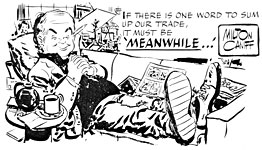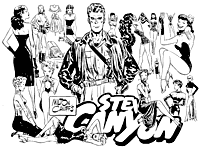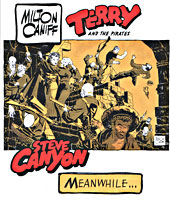The
Definitive Biography of the Legendary Creator of Terry and the Pirates and
Every artist, every writer, deserves to
be judged on his or her best work, and Caniff’s best work remains one of the
glories of American popular culture. —Pete
Hamill
Caniff introduced serious sexual
inference into the comic strip—the Dragon Lady for certain, but even more
markedly with the character of

Milton
Caniff is one of the few authentic giants in the history of cartooning: his
achievements in the comic strip form set standards by which all storytelling
strips were subsequently judged. Caniff became one of the profession’s youngest
nationally syndicated comic strip cartoonists in 1933 with Dickie Dare, and he rose to prominence during World War II when he
took the characters of his Terry and the
Pirates into the war.
The trenchant pragmatic patriotism
of the strip warmed hearts and steeled nerves on the homefront as well as on
the battlefield. When Terry won his wings and got a pep talk from Colonel Flip
Corkin, that strip was read into the Congressional
Record. Not content to devote his morale-building to his syndicated strip,
Caniff also produced a wartime feature expressly and exclusively for the armed
forces: Male Call, a mildly risque
weekly strip that he drew without remuneration for distribution as a
morale-booster to camp and unit newspapers (March 1943-March 1946), focused on
Miss Lace, a curvaceous bundle of camaraderie who, as Caniff said, was the
central figure in the strip because she had one. As he usually put it, she was
a reminder to servicemen of “what they were fighting for.” Immensely popular,
the strip was published regularly in more than 3,000 papers, the greatest
circulation in number of individual publications ever attained by any comic
strip.
Even before his strip’s entry into
the War, Caniff’s achievements in the comic strip form re-shaped the adventure
genre and set standards by which all storytelling comic strips were
subsequently evaluated. He developed an impressionistic chiaroscuro style of
drawing that suggested reality economically with shadow rather than with
painstakingly rendered details, and he insisted on absolutely authenticity in
depicting every visual detail in the strip. He also enhanced the simple
melodrama of adventure strips by making character development integral to
action-packed plots. In Terry, he
created many colorful characters—the stalwart Pat Ryan, irrepressible Connie,
Burma the shady lady, wise-cracking Hotshot Charlie, Big Stoop, the giant mute,
and, most memorable of all, the enigmatic Dragon Lady, a beautiful but
mysteriously menacing pirate queen who turned Chinese patriot during the War.
After the War, Caniff caused a fresh
sensation by leaving Terry and
launching a new strip,

In Meanwhile: A Biography of Milton Caniff (a massive 950 6x9-inch
page tome), comics chronicler Robert C. Harvey rehearses the cartoonist’s life,
marking along the way the milestones in the development of comic strip artistry
that Caniff established. His innovations and techniques are thoroughly analyzed
and the histories of his characters are amply reviewed. Herein, we learn the
secret origins of the Dragon Lady, what Noel Sickles did (and didn’t) do in
shaping Caniff’s distinctive drawing style, and whether the cartoonist was a
hawk or a dove.
In addition to recording Caniff’s
rise to fame and fortune through the exercise of artistic excellence and
patriotic fervor, the book describes the ironic decline of his strip’s
popularity in its last years when the same brand of patriotism that had
inspired admiration during World War II provoked virulent protest during the
Vietnam War, a bittersweet conclusion to a career spent producing a daily
feature for 55 years, a record that would stand for a generation.
In examining the life and work
routines of a nationally distributed cartoonist whose career was so central to
the development of the artform, the book necessarily touches upon the history
of the medium and reveals the inner workings of the syndicate business, at
which Caniff was as expert as he was at creating comic strip continuity. He
adapted deftly to changing fashions: as the gag-a-day comic strip gained
popularity and the storytelling strip began to fade, he gave each of his daily
strips a punch line conclusion, hitching the new fad to his proven formula; but
he could not escape the consequences of producing a military-themed feature
during the Vietnam period when the military fell so far from public favor.
The biography of one syndicated
cartoonist, the book is, at the same time, a lingering look into the lives and
careers of all syndicated cartoonists, of whom Caniff was nearly archetypal.
The book is copiously if not exactly profusely illustrated with well over 400
pictures— sample strips from all periods of Caniff’s career (which build an unimpeachable
case for his status as the all-time master of black-and-white comic strip art),
and also personal photographs, sketches, and other rarities from Caniff’s
files.
Caniff was undoubtedly the most
honored cartoonist in the profession. He received honorary degrees from several
institutions and awards from dozens of organizations to which he contributed
time and talent. His support of the U.S. Air Force earned him many accolades,
including the USAF Exceptional Service Award (the highest for a civilian). For
his work with the Boy Scouts, he received both the Silver Beaver and Silver
Buffalo. He was twice (1946 and 1971) named Cartoonist of the Year by his peers
in the National Cartoonists Society, an organization he helped found, serving
as its second president (1948-49) and as honorary chairman for 17 years.
Despite his many accomplishments, Caniff persisted all his life in thinking of
himself as a newspaperman whose job was to sell tomorrow's paper.
Meanwhile...: A Biography of Milton Caniff, Creator of Terry and the Pirates and Steve Canyon, by Robert C. Harvey; 950 pages in hardcover, $34.95 from Fantagraphics Books, Inc., but only $30 (plus $5 p&h) from this site. It’s cheaper from Amazon, kimo sabe, but this is the only place you can get a copy signed by the author and inscribed to you (or to whomever you specify when ordering).

